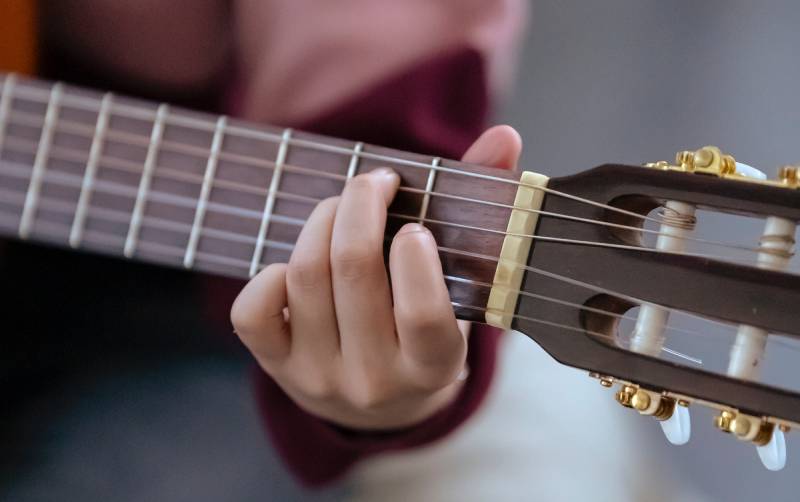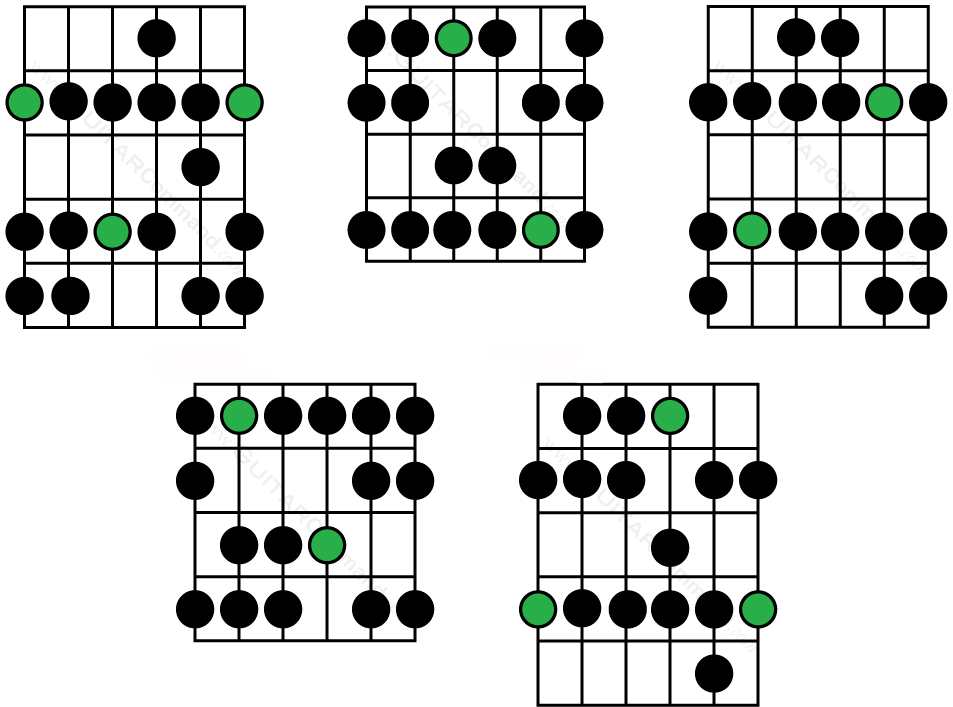
Calf: The Foundation.
January 8, 2022
Mask On: Mask Off
February 3, 2022- acoustic guitar lessons
- better sound from your acoustic guitar
- can your acoustic sound better
- easy guitar lessons
- first guitar lessons
- first lessons in guitar
- guitar beginner lessons
- how to start learning the guitar
- improve your guitar
- improve your guitar sound
- make your acoustic easier to play
- new to guitar
- starting guitar again
- tips for maintaining an acoustic guitar
- ways to improve your guitars sound
Make your Acoustic guitar sound better
 Most of us, including myself, are not fortunate enough to own a Gibson Hummingbird (in pic) or a Zager Acoustic guitar. We have what we can afford but that does not mean that we cannot get the best sound by getting our beloved acoustic guitar to sound better.
Most of us, including myself, are not fortunate enough to own a Gibson Hummingbird (in pic) or a Zager Acoustic guitar. We have what we can afford but that does not mean that we cannot get the best sound by getting our beloved acoustic guitar to sound better.
Let us be perfectly clear though, there is a reason why some guitars cost a liver and a kidney while some are quite affordable. If you think you can get an average guitar to look, sound, and have playability like a custom-made acoustic, well, it’s not going to happen.
You can still get it to be the best it can be.
Good enough for most of us mortals.
Also Read: The Lesson B4 the lesson
Why are some guitars so Expensive?
 The most important and therefore the most expensive part of an acoustic guitar is the wood used in its construction. The woods used for acoustics are called ToneWoods, for their tonal characteristics.
The most important and therefore the most expensive part of an acoustic guitar is the wood used in its construction. The woods used for acoustics are called ToneWoods, for their tonal characteristics.
The most sought after woods are becoming rarer by the day leading to prices rising astronomically. Some are not even available anymore.
The next cost factor is the skill and reputation of the Luthier. This is an important consideration as the most skilled and reputed craftsman directly corresponds to the overall price factor.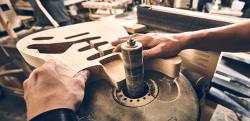
Then come the bits and pieces which complete the guitar, like the tuning keys/ mechanism and the bridge pegs, for example. Just like parts for any product, these can come in a range of quality and prices.
So we can understand that the most expensive guitars have the best of all points and the average guitar sacrifices on most fronts. The ranges In Between incorporates compromises by choosing one or more aspects over the others.
Also read: Wood for guitars.
Enough Already!!!
Alright.
Here are a few best practices that can get your acoustic guitar to sound better than it currently does.
Clean it
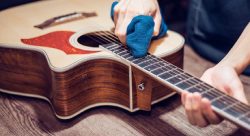 This is a no-brainer but there is a practical side to it other than merely the aesthetics. Sweat and Grime build up every time you play your guitar. Although the body of the guitar does have a finish, sweat and grime are corrosive over time and the attractive finish of your guitar would be finished.
This is a no-brainer but there is a practical side to it other than merely the aesthetics. Sweat and Grime build up every time you play your guitar. Although the body of the guitar does have a finish, sweat and grime are corrosive over time and the attractive finish of your guitar would be finished.
Moreover, body oils can get into the wood of your guitar and this is the beginning of the end of the integrity of the body.
The other part of the guitar most affected by our grime is the fingerboard. Every time we play we leave skin cells trapped in the gut of the string and deposited in the groves of the fretboard and in the notches of the fret itself. This not only discolours an attractive fretboard but also corrodes the fret and the wood. Grease and body oils also decrease the life of a set of strings significantly and change the tone of the set as well.
Wipe your guitar after every session and clean your guitar with a body polish and fretboard cleaner once a fortnight if you are a daily player.
Remember, a good clean guitar silently encourages us to pick it up and play.
Guitar Body and Fretboard Cleaners
2. Change the strings
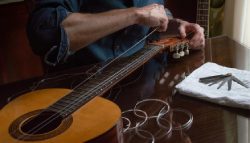 If you use branded strings this is not easy on the wallet, especially if you are a student and have to ask for funds. The quality of the strings does matter and the better the quality the better the tone.
If you use branded strings this is not easy on the wallet, especially if you are a student and have to ask for funds. The quality of the strings does matter and the better the quality the better the tone.
But, the fact remains that old, overused, and oxidized strings of the best brand will sound worse than brand new strings of an economical brand. So buy your strings according to the affordability factor and change them on time.
When do you change the strings?
Guitar strings start to deteriorate as soon as they are out of the air-sealed packaging. Oxidation of strings does not even require them to be installed on a guitar, exposure to the air is enough. As strings get old and oxidize, producing an accurate note and its natural harmonics are drastically affected.
You should change your acoustic guitar strings when the guitar doesn’t stay in tune, has poor intonation, or just sounds dull.
A tuned guitar that is out of tune almost immediately indicates that the strings have lost their tension and are old, replace them.
If the notes at the 7th fret are out of tune but the open string is in tune, the strings aren’t holding intonation, replace them.
If your guitar sounds like all the brightness has disappeared and the sound is muffled, then your strings are dead. Replace them.
A good rule of thumb is to change strings at least every 3 months or 4 times a year.
Because as a beginning guitarist, it is difficult to hear minute tonal and note differences.
Now if you’re playing a lot and regularly, then this frequency would increase.
also read: How To Change Strings
3. Death of a Guitar
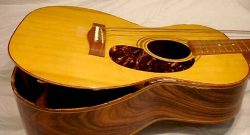 Have you ever experienced a door in your house that shuts with a bit of a gap in the summer and tends to get stuck during the monsoon? That is nothing more than the wood reacting to the moisture in the atmosphere.
Have you ever experienced a door in your house that shuts with a bit of a gap in the summer and tends to get stuck during the monsoon? That is nothing more than the wood reacting to the moisture in the atmosphere.
The humidity level plays an important part in the lifespan of a guitar. It is made of wood after all, isn’t it?
An atmosphere too dry makes wood brittle and prone to cracks, while a wet one makes it take on moisture to the point of deterioration. We have all seen wood exposed to moisture, the resultant fungal growth, and the easy flaking of the soft grain.
It is not possible to get a perfect environment for your guitar unless you have a temperature and humidity-controlled closed environment for storage. We can, however, protect our guitars by insulating them from the environment as best we can. Hard guitar cases, hygroscopic materials like a packet of activated charcoal, and a non-absorbent cloth covering to protect the body and the fretboard are some of the things we can do to protect and extend the life span of our guitars.
Remember:
Extreme exposure to moisture and/ or dryness can warp the fretboard to the extent that the guitar is unplayable and/ or repair of the same would be more expensive than a new purchase.
also read: In-depth discussion on humidity and guitars
4. The killer fret buzz
 Fret buzz is the metallic sound you get when you play chords, individual notes, or both. This can occur across the fretboard or on particular positions on the neck or even on individual strings. This is one sound you do not want and if making your acoustic guitar sound better is your goal this has to be rectified.
Fret buzz is the metallic sound you get when you play chords, individual notes, or both. This can occur across the fretboard or on particular positions on the neck or even on individual strings. This is one sound you do not want and if making your acoustic guitar sound better is your goal this has to be rectified.
This is usually cause by the warping of the fretboard, either inward or outward, and/ or by the difference in wear of individual frets.
To check and isolate the location of the buzz you would need to play every note on the fretboard and listen for an unclean sounding note. This is a job for a professional as it requires technical expertise to rectify and trying to do it on your own could make it even worse.
When you do check for buzz make sure you do it with a new or fairly new set of strings as sometimes old and oxidized stings would contribute to unwanted noise.
5. the nut
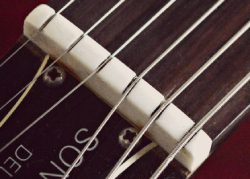 The nut is the part on the neck at the start of the fretboard. The slots through which the strings run should have a rounded bottom. Due to heavy use and the passage of time these slots tend to wear out into a V shape.
The nut is the part on the neck at the start of the fretboard. The slots through which the strings run should have a rounded bottom. Due to heavy use and the passage of time these slots tend to wear out into a V shape.
This shape prevents the open string from vibrating naturally and of course, the sound would deteriorate.
If you find that the sound of the guitar is better while playing barre chords and not as good when playing open chords, the nut could be the fault.
The entire piece needs to be replaced in this situation and again it is better left to the professionals.
6. The saddle
 The saddle is the other end of the guitar where the strings terminate.
The saddle is the other end of the guitar where the strings terminate.
Just like the nut, the saddle has grooves as well and is prone to the same wear and tear issues.
Here, an additional point would be saddle height and rigidity.
Improper saddle height would lead to an improper height of all strings from the fretboard and make the guitar either difficult to play or cause buzz while playing.
Incorrect rigidity of the saddle would result in the strings not being held properly or held so tight that it affects their vibration characteristics.
Do not ignore the bridge pins, the pegs which fix the strings to the body of the guitar. Loose pins would pop out suddenly or would not let the string hold tune.
Again a job for someone who knows what he’s doing but an important one if you want your acoustic to sound better.
7. TUSQ or Bone
This is more to do with the material used to manufacture guitar nuts and saddles than a specific defect with the guitar.

TUSQ is a polymer; a material with high density that is incredibly uniform.
Bone is the default material for both nuts and saddles for gaining the best tone out of your acoustic guitar.
The lower-end guitars are the ones that would benefit the most from a nut and saddle change as they generally use hard plastic as the material to cut costs. The result is that hard plastic is not durable enough and does not support the tone as well as the above-mentioned materials.
Although not essential to do if your guitar is new, it is a good idea to upgrade when the original nut and saddle wear out.
Upgrading the nut and saddle from plastic to bone or TUSQ is a great way to make your acoustic sound better.
8. guitar electronics
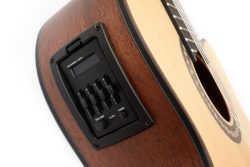
Up to now, we have dealt with purely acoustic guitars.
But if you are using a semi-acoustic or an electric there is another ingredient in the mix. A semi-acoustic or an electric will be plugged into an amp. If you are getting some strange noises, there could be some problems with the onboard preamp, or the pickup element itself.
Listen intently while playing the guitar without plugging it in as mentioned in the above points, just like an acoustic. If it’s all good the fault may lie with the electronics, the cables, or the amplifier itself.
Again not something the beginning guitarist should attempt to rectify on their own.
9. Loose Bracing
 One cause of unusual guitar sounds and tone is the internal bracing and other structural elements that have come loose.
One cause of unusual guitar sounds and tone is the internal bracing and other structural elements that have come loose.
Remove the guitar strings. Hold the guitar up by the neck and lightly thump the guitar with the heel of your free hand. Do this all around the body and listen for any rattle or sounds from within. It should sound tight, like a drum.
Stick a light into the guitar and look for cracks through which the light would pass through. Also, look for any imperfections in the wood internally in the guitar.
Crack and brace repairs should be done only by a professional. These have a major impact on the tone of the guitar and incorrect or unskilled work would only make things worse.
10. A full setup
This is like the service interval for your car, done by a professional mechanic.

A full setup will include replacing the strings, cleaning the guitar, adjusting the neck if needed, checking the nut and saddle, replacing the preamp battery if needed and checking the electronics, and ensuring that there aren’t any structural issues that need to be addressed.
This is essentially everything covered in all the above points in one go.
The Catch: Just like a regular car service, it costs money, and depending on where you get it done the cost may vary.
In conclusion:
Maintain your guitar as best as you can by following the tips mentioned. When things get beyond your capabilities then go straight to point 10. This would be advisable as at this point trying any DIY could make things worse and it could be even more expensive to rectify.
Regular maintenance of your guitar would not only keep your guitar visually appealing but also get your acoustic to sound the best it can be.
Additional Reading: Improve your guitar


